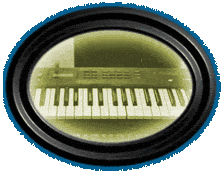Kawaii K1-II
The K1 is an old stalwart that has been gigged hard, long before SHotQ
came into existence. This is noticeable when you look at the instrument:
it's dirty and dusty, and one key (lowest G#) points in an unnatural angle
from the keyboard. Also, some of the eraser-like membrane
switches have become rather insensitive over the years, demanding strong,
stubborn fingers to work properly. Inside it's in good condition however,
this old digital pioneer!
Also, some of the eraser-like membrane
switches have become rather insensitive over the years, demanding strong,
stubborn fingers to work properly. Inside it's in good condition however,
this old digital pioneer!
Kaway K1 was introduced by the end of the eighties (88 maybe?) and was a minor sensation with its sampled sound snippets and then fashionable digital sound. The editor remembers a Swedish magazine celebrating it as "synth of the year" - in the same issue as Korg M1 got the same title by another reviewer! You could call K1 a poor mans M1, even though the latter sounded bigger with its built-in effects. To SHotQ, a Korg M1 would be totally pointless though, while the K1 have a few bizarre qualities that make it valid and useful.
A K1 sound is based on two or four "sources". For each source, you can select a waveform (a single cycle waveform or a sampled snippet - some of these are looped), make settings for pitch and amplitude envelope. There are surprisingly many settings for velocity sensitivity, keyboard tracking and aftertouch. Vibrato and Auto Bend parameters are common to all sources, but you can disable these for individual sources if you like. Finally there's the option to amplitude modulate two sources by each other, which can create ring modulation-like effects, nasty and dirty sounds or just subtle movements in the sound.
This is basically it! By this you may realize that the K1 has no filters. This makes traditional filter sweeps and similar impossible (although you can try to fake those by crossfading waveforms with different harmonics). What the K1 does best is instead sharp, fuzzy and plunky sounds. You can also program excellent electric pianos and organ sounds.
The internal resolution is most likely eight bits, resulting in some noise but also interesting digital artefacts when you walk into the highest octaves. We have used these artefacts for bird sounds in Botongdjungelboken, etc.
On with the architecture: The K1 has the now-standard "Performance mode", where single synth programs can be combined for multitimbral playing. Here you can select eight different programs and specify volume, transposition, and whethere they should be played via MIDI, from the keyboard or both. A very handy and well thought-out way to set things up, and probably one of the reasons for the K1's success when multitimbrality was all the rage. A funny detail is that the processorn isn't quite fast enough if you layer a lot of sounds and play them at the same time from the keyboard - by putting your elbox across the keyboard you can get totally unexpected arpeggio effects!
SHotQ's instrument is a "K1 II", an updated version of the original K1. The differences are a simple, global reverb/delay effect and some separate drum sounds. These are made with the same synthesis as the rest of the synth (no new samples, that is) but can have a separate MIDI channel (making the instrument multitimbral with nine parts). We also have a K1R, which is the rack version of the original K1.
Our K1s can be heard here and there throughout SHotQs production - for details, do some detective work in the sound source listings for our songs!